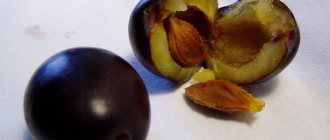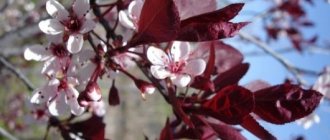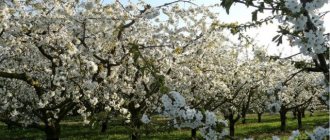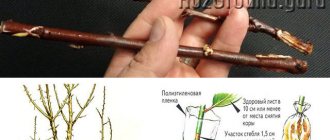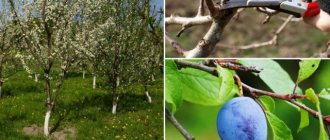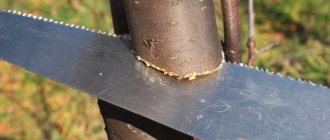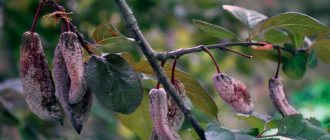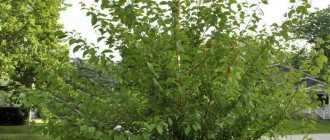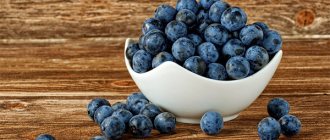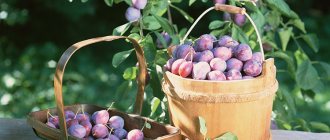Plum crop beds
Plum is considered one of the most common fruit crops. To date, many varieties of plum trees have been registered. However, modern farmers highly value the Startovaya plum, which is characterized by good yield and excellent gastronomic qualities of the fruit.
- 1 Description and characteristics of the variety
- 2 Agrotechnics of cultivation
- 3 Diseases and pests
- 4 Video "Plum planting rules"
Description of the plum variety Startovaya
- The height of the starting plum tree is medium.
- The crown is thick, oval.
- The shoots of Startovaya are red-brown, with a silvery bloom. Buds are conical, silvery-brown in color.
- Small emerald oval leaves have a wrinkled texture and a pointed tip. Small ribs are located along the edges of the Starter Plum leaf. The stipules of the plant fall early.
- Petioles are ordinary, slightly pigmented. The glands have an amber hue and are located one by one on the petiole.
- The starting plum blooms with large white flowers resembling a bell. Their anthers are located under the stigma of the pistil.
- The fruits of the Startovaya variety are large, have a dark purple color and a whitish tint. They are distinguished by high taste (average tasting score - 4.7 points out of 5). The fruits are sweet and sour. The stone is large, oval, it is easy to separate it from the juicy yellow pulp. On average, the fruit of the Start Plum reaches a mass of 52 g.
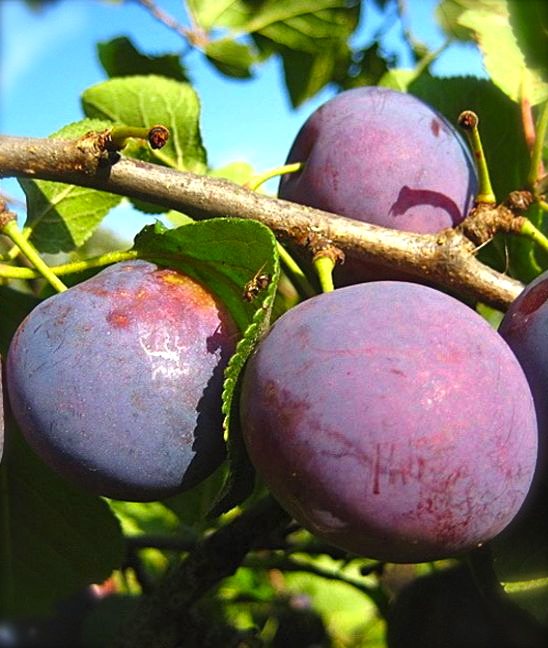
The starting plum is grown in the Central Black Earth region of Russia, in Ukraine, in the south - in Georgia and Moldova, in the north - in Estonia. Areas with loamy soil are ideal for cultivation.
Plum characteristics Start
Drought resistance and frost resistance
The starting plum is frost-resistant; during mild winters, there is no need to cover the tree for the winter.
Plum loves warmth and calmly tolerates heat, although it requires additional watering.
Most of all positive reviews about the Startovaya plum are located in the Moscow region, where the climate is moderate, but the reviews about the Startovaya plum in Siberia are contradictory: only with careful care it is possible to preserve the seedlings and get a good harvest.
Plum Pollinators Home
Plum Starter is considered self-fertile, but it gives very few ovaries. To get a good harvest, Startovaya plum needs a pollinator. As pollinators, it is best to choose the parents of the variety: Eurasia-21 plum and Volga beauty.
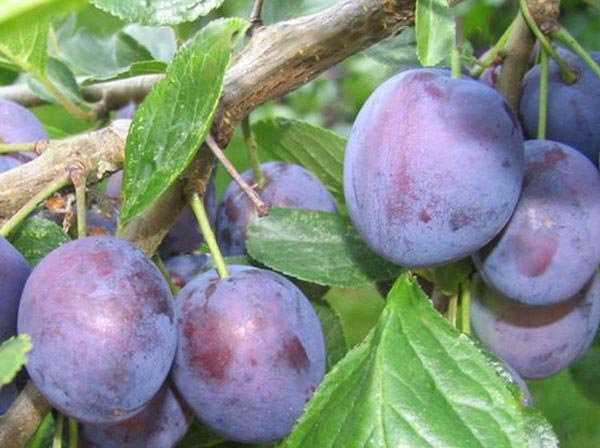

Productivity and fruiting
Plum variety Startovaya ripens very early and bears fruit. Its yield is about 61 centners of fruits per hectare (up to 50 kg per tree).
Shelf life is approximately 3 weeks (no more than 25 days).
For the first time, a plum bears fruit 4–5 years after planting the cuttings or 6 years after planting the seed.
Scope of berries
Plum of the Startovaya variety is universal. It is grown by private gardeners for home use, and by owners of large land for sale fresh, and farms for the production of various products: wines, candied fruits, jams, compotes, mousses.
Fruits of the Startovaya variety can be frozen without loss of taste.
Disease and pest resistance
The Startovaya variety is resistant to diseases and pests, therefore it does not require treatment with fungicides and insecticides.
Advantages and disadvantages of the variety
Advantages:
- very early fruiting;
- high productivity;
- resistance to low and high temperatures;
- ease of transportation of berries;
- high taste;
- versatility of use;
- immunity to diseases and pests.
Disadvantages:
- conditional self-fertility of the plum Starting.
Reviews:


I planted Startovaya one year after it appeared. I found information on the Internet and ordered a seedling. Fruiting came in 5 years. The fruits turned out to be even larger than promised and exceeded the 60-gram mark. And the taste and smell of the fruit simply attracted them to eat.
I love plums more than other fruits and berries, and every time I buy them on the market, I wondered if I should plant a tree myself. Walking past sellers with seedlings, one man advised me to buy this new variety. Last year I got my first harvest. The fruits were few, but they were large and so tasty that I ate them slightly unripe. Now I am looking forward to the new harvest of these wonderful plums.
The starting one tasted great! The first year I bore fruit. They took off its fruits early, following the hybrid plums - late July, early August, very early for home plums. The pulp is sweet (almost without acidity), juicy, yellowish (as I like), the stone separates well. The plum is very large, one piece fits in the hand. The tree is tall, slightly thickened, needs pruning. The yield for the first year is small, besides, at the time of the flowering of the plum, we had frosts. I was pleased with the taste of this plum. This variety was recommended to me in the nursery by a respected professional gardener. I always listen to his recommendations when choosing fruit and always his advice on the matter!
Early fruit is always valuable. Therefore, lovers of juicy plums choose the Startovaya variety. It was created at the Michurin All-Russian Research Institute of Genetics and Breeding of Fruit Plants. The Volga beauty and Eurasia were used for crossing 21. The authorship was assigned to themselves by G.A. Kursakov, T.A. Nikiforova, T.A. Pisanov and R.E. Bogdanov. Registration date 2000. The variety was entered into the State Register of Breeding Achievements of the Russian Federation in 2006. The region suitable for growing is the Central Black Earth (Belgorod, Kursk, Voronezh, Lipetsk, Tambov Regions). But plum has a good reputation also in Belarus, Ukraine, Moldova, Estonia and Georgia.
Landing features
Recommended timing
The starting plum should be planted in late March - early April (2-3rd decade), or from September to mid-October, before frost sets in. In autumn, seedlings do not respond to damage to the root system. At the same time, it is easier to buy high-quality planting material.
Important! When planting in autumn, the seedlings must be covered for the winter.
The planting material planted in spring has time to develop the root system and easily survive the winter.
Choosing the right place
- Startovaya grows best on loam.
- Ideally, the acidity of the soil should be in the region of 6.5-7 units. It is easy to check it with the help of litmus paper, for this it is enough to attach the meter to a handful of damp earth after rain.
- Do not plant the Starter in a place where the groundwater level exceeds 2 meters: the plum is sensitive to excess ground moisture.
- It is best to plant it in a place where it will constantly be under the rays of the sun and protected from the northerly winds.
In such conditions, the fruits of Startova will ripen sweet and juicy.
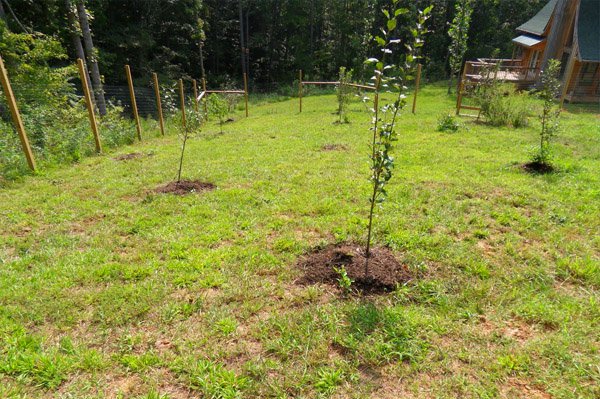

What crops can and cannot be planted nearby
- Another plum variety that is compatible with it should be planted next to the Start. Eurasia-21 and the Volga beauty, which are its best pollinators, are best suited.
- It makes no sense to plant a number of plum varieties that do not coincide with this variety in terms of flowering time.
- Plums should not be planted next to cherries, cherries, pears, walnuts.
- She gets along well with apple or berry bushes: raspberries, currants.
Selection and preparation of planting material
It is very easy to grow a starter plum from a seed or a cuttings. Bone planting will be cheaper and easier.
- The seeds are split, the seeds are removed and pre-soaked in warm water for 70-120 hours, changing the water once a day.
- After that, the bones are stored in a clean glass container.
- 6 months before planting, the seeds are stratified in damp sand at temperatures ranging from -10 to 1 degrees.
- 2 years after planting, the cutting can be transplanted to another location if necessary.
Today on the market you can find
- seedlings grafted on seed stocks;
- own-rooted seedlings;
- seedlings grown from root shoots, cuttings, cuttings.
For the Starting plum, it is best to buy self-rooted planting material: a fruitful tree will grow from it, consistently giving a bountiful harvest and easily tolerating frost.
For planting, one-year and two-year seedlings are suitable.
Important! Regardless of age, seedlings should have 3-5 main roots 25-30 cm long.
The indicators that are important when choosing are described in the table.
| Age, branching | Height | Barrel diameter | Length of main branches |
| 1 year, unbranched | 110-140 cm | 1.1-1.3 cm | |
| 1 year branched | 40-60 cm (stem height) | 1.2-1.4 cm | 10-20 cm |
| 2 years branched | 40-60 cm (stem height) | 1.6-1.8 cm | 30 cm |
Comment! The trunk diameter of branched grafted seedlings should be measured in a place located 10 cm above the graft.
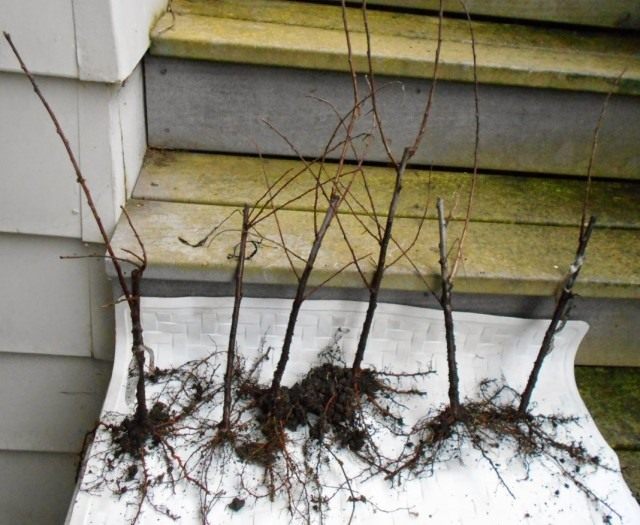

Landing algorithm
When planting seeds, you need to wait until they germinate in the process of stratification. It is also necessary to prepare a sufficient amount of drained soil and compost.
- When the roots are visible, the seeds should be planted in a pot or immediately on the site, having previously dug a hole.
- In the center of the hole, an elevation should be made from the ground, the seed should be placed there, the roots should be carefully laid out and the seed should be buried.
When planting seedlings in spring, pits for the Starting plum are prepared in the fall. At the same time, it is easiest to buy seedlings, since at this time the market offers the widest selection of planting material. They should be kept buried until planting. If it is decided to plant a plum in the fall, the pits should be prepared a month before planting.
- Plums are best planted at a distance of 3-4 m from each other and 5-6 m between rows. Start plum trees in Siberia and the Far East should be at a smaller distance - 2-3 m from each other and 3-5 m between rows.
- The pits should be 70–80 cm in diameter and 70 cm deep.
- When digging, the top layer of the soil should be placed in one direction, the bottom in the other.
- If the soil is peaty or sandy, fill the pit to a 10 cm level with clay.
It is also best to fertilize the soil before planting. The recommended fertilizer composition is as follows:
- humus and compost - 2 buckets;
- peat - 2 buckets;
- superphosphate - 1 tablespoon;
- urea - 3 tablespoons;
- potassium sulfate - 3 tablespoons.
This mixture will help the Starter Plum take root faster and better. You should also add 2 cups of nitrophoska and 200 g of wood ash (an alternative to ash is fluff lime, dolomite flour).
With increased acidity of the soil, you need to add nitrate with lime and ammonia, this will saturate the earth with nitrogen.
- If the soil is heavy, the bottom of each pit should be loosened to a depth of 20–25 cm.
- In the removed topsoil, add 20 kg of the prepared fertilizer.
- A 110-centimeter peg is dug into the bottom of the pit.
- Eggshells are placed in the pit, then it should be covered by two-thirds with a mixture of soil and fertilizer. If there is not enough mixture, you need to take some more soil from the topsoil.
- The seedling needs to be spread out the roots and placed in the hole.
Important! The root collar should protrude 3-4 centimeters above the ground.
- The pit is filled up to the end with ordinary soil without any fertilizers.
- Thoroughly compact the soil: this will protect the roots from contact with air and, therefore, drying out.
- In order for the Startova plum to absorb moisture to the maximum, you need to make an embankment around the seedling from the lower soil layer.
- The seedling should be tied to a peg and watered abundantly (3-4 buckets of water).
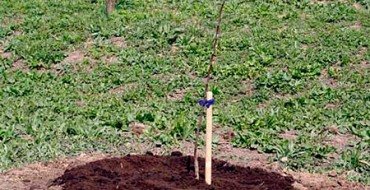

Growing
The tree planting site must meet certain conditions:
- the sun should penetrate to it unhindered throughout the day;
- it should not be blown by a cold wind;
- groundwater should not be closer than 1.5 m;
- the earth should freely pass moisture and air, it is preferable to stay on loams with a neutral reaction.
It is advisable to plant in the spring, but in the southern regions you can do this in the fall. A hole up to 50 cm deep should be dug in advance, add humus to the soil. For support, the seedling can be secured to a peg. The land must be tamped, watered and mulched.
Plum follow-up care
Pruning
The largest yield is yielded by the Starter plum with the correct crown. For its formation, it is necessary to trim from the moment of planting.
- In the first year, the trunk is cut to a level of 1–1.2 m.
- For biennial plums of the Startovaya variety, the most powerful branches are cut to a length of 25-30 cm.
- In the third year, the apical growths are cut by 30 cm, the lateral ones by 15 cm.
As a result, the Startovaya plum should have 5–6 branches growing at an angle of 50 degrees. The cup-shaped shape should be maintained and the density of the branches should not be allowed: this is fraught with a lack of light for the ovaries and fruits and, consequently, a decrease in yield.
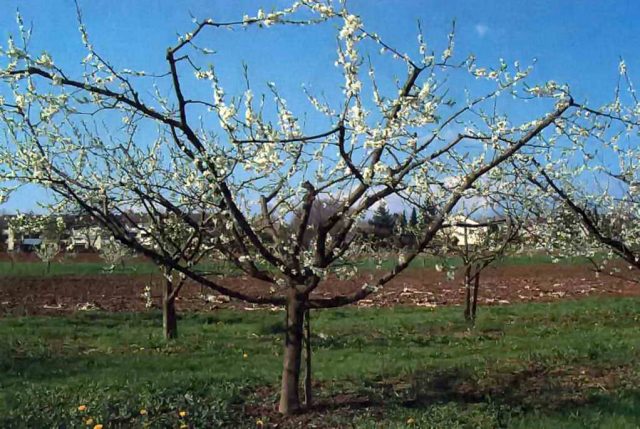

Watering
Plum grows well in conditions of excess moisture, therefore, the Start must be watered regularly, especially for newly planted plants. Watering is especially important for spring seedlings, as the soil dries out quickly during the warm season. For mature trees, one watering per week is enough. A young Startovaya plum needs 5–6 buckets for watering, a fruiting one - up to 10 buckets. The plum also needs watering in the fall.
Important! Water stagnation around the Start Plum is unacceptable! Watering should be abundant, but not excessive.
Preparing for winter
Plum Startovaya easily tolerates mild winters and does not require insulation, however, if grown in the northern and northwestern regions, preparation for winter is necessary.
- Plum Starter should be whitewashed, this will somewhat protect it from frostbite.
- Around the young tree, you need to lay out several bags and fix them with soil. In especially severe frosts, it is necessary to put several layers of burlap.
- An adult tree can be insulated by mulching with humus.
- The near-trunk circle of a young Start plum is covered with polyethylene to minimize the harmful effects of precipitation.
- After the first snow, a snowdrift is made around the base of the trunk for additional insulation.
- Snow should be trampled around young trees to protect them from rodent attacks.
- In case of heavy snow, it must be knocked off the branches to avoid breakage.
By the end of February, you need to remove the harness from the drain, take it out of the garden, remove snow from the trunks.
Top dressing
The starting drain needs 3 fertilizers per year: in spring, summer and immediately after harvest.
The Starter variety should be fed
- urea;
- superphosphate;
- wood ash;
- phosphates;
- nitrogen fertilizers.
Rodent protection
Most rodents make moves at a depth of 10–20 cm. Reliable protection from their attacks will be a chain-link mesh dug around the Start plum by 40–50 cm. The diameter of such a mesh should be 60–70 cm. This will not interfere with the root system, and the tree will be reliably protected.
An alternative option is placing traps. Depending on the type of animal, vegetables and herbs, bread fried in vegetable oil, lard can be used as bait. Also, this bait can be treated with poison and spread out on the site.There are also specialized preparations, such as "Ratobor", which is very attractive to pests for its taste and smell and is easy to use.
Diseases and pests, methods of control and prevention
The variety is not susceptible to most diseases and mass attacks of pests, therefore it does not require annual preventive procedures. Chemical treatment is necessary only when symptoms of a particular ailment are detected.
Diseases and pests
The main diseases that occur in Nick plum include powdery mildew, olive spot, fruit rot, and perforated spot.
- Spraying with a manganese solution (30 g per 10 liters of water) will help get rid of fruit rot.
- It is better to use "Acyclovir" against olive spot (40 g per 5 liters of water).
- In the fight against powdery mildew, Bordeaux liquid comes to the rescue (50 g per 10 liters of water).
- A solution of colloidal salt (70 g per 8 liters of water) helps with perforated spotting.
Treatments against diseases are carried out at intervals of 15 days.
Plum of this variety is often affected by aphids, moth and flea. You need to fight pests with the help of chemicals. Against aphids use a copper-containing drug "Oxyhom" (30 g per 5 liters of water). It is better to use “Khomus” solution against flea beetles (50 g per 7 liters of water). Copper sulfate saves from the moth (20 g per 6 liters of water). It is also used for prophylaxis. Spraying from pests is carried out once a month.

